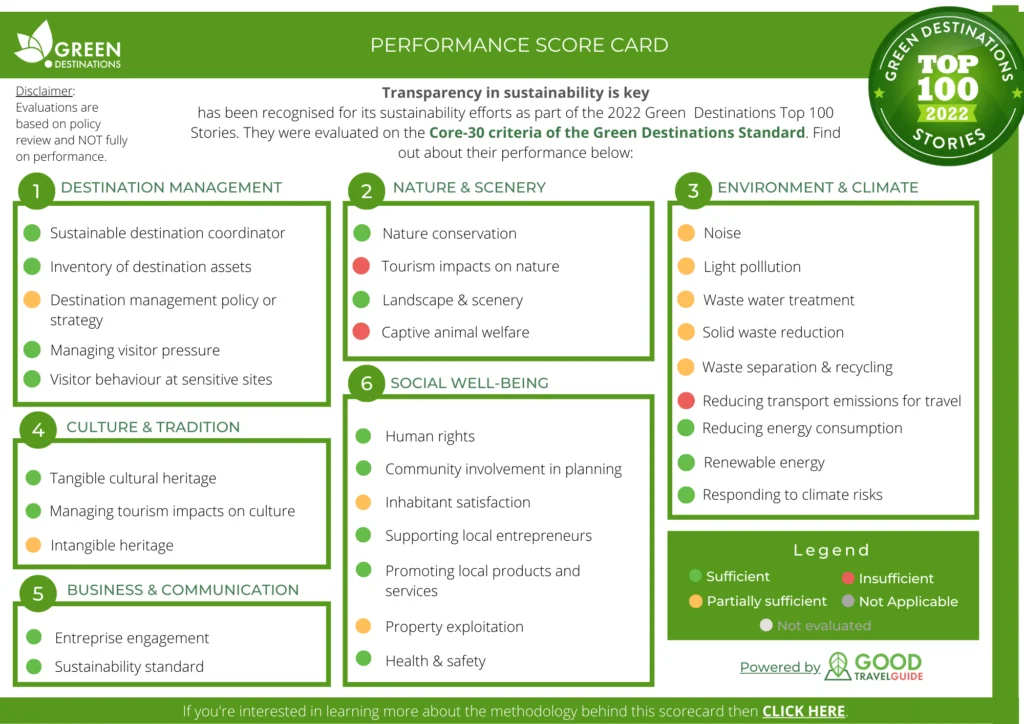© Good Travel Guide, Oct 2022
When it comes to sustainability it is important to be transparent. Transparency, builds trust and shows what an organisation believes in and what they are working on to improve. If you’re anything like us at the Good Travel Guide, you are becoming more aware of what is honest and not just marketing greenwashing, and are looking for trusted standards and real action to make choices. The good news is that all the destinations featured in the Good Travel Guide have been certified, awarded, or recognized for their efforts towards a more sustainable tourism industry by Green Destinations. Green Destinations is a non-profit organization for sustainable destination development and recognition. In service of transparency, the Good Travel Guide created sustainability performance scorecards showing the level of compliance of destinations with the Green Destinations Core Criteria.

Green Destinations’ Core Criteria
The Green Destinations Core Criteria were introduced in 2014 and have been identified as the foundation for destination sustainability. It is a set of 30 criteria from the Green Destinations Standard, covering all 6 themes of the standard (see below), therefore, offering a well-rounded overview of the destination’s sustainability performance.
- Destination management
- Nature, animals & scenery
- Environment & climate
- Culture & tradition
- Social well-being
- Business & hospitality
Green Destinations’ recognition of sustainability can happen at 2 levels:
- Awarded or certified destinations: have been audited by an third-party auditor on all 84 criteria of the Green Destinations Standard.
- The Top 100 destinations: have self-reported and been evaluated by Top 100 evaluators on the 30 Core Criteria. Destinations participating in the competition for the first time are only asked to self-report and be evaluated on half of the Core Criteria (15 criteria instead of 30).
Evaluation of core compliance
For each level, the recognition processes are different:
- Awarded and Certified destinations: receive insufficient compliance / partial compliance / sufficient compliance indicators for each criterion from the third-party auditor in the audit report.
- Top 100 destinations: are evaluated by two Top 100 evaluators, who rate their compliance on each of the Core Criteria on a scale of 1 to 5 (1 being insufficient, and 5 indicating full compliance). Final results are calculated by doing the average of both evaluations.



How were the scorecards created?
For a matter of consistency, a convention was created to align both recognition processes and present you with clear information:
- For Top 100 destinations: the Green Destinations Top 100 team shared the results of the sustainability assessments of the 2020 Top 100 destinations with us. From there, the Good Travel Guide created the following convention for the best representation of sustainability performance (see convention on the scorecard):
- Top 100 evaluation score below 1.5 = Red bullet, insufficient compliance
- Top 100 evaluation score between 2 and 3.5 = Orange bullet, partially sufficient compliance
- Top 100 evaluation score above 4 = Green bullet, sufficient compliance
When the destination is only evaluated on 15 criteria, the 15 that it was not evaluated on will be written in very light grey.
- For the Awarded or certified destinations: the results of their audit are confidential. The Good Travel Guide, therefore, needs approval from the destination first to create a scorecard. The convention on the scorecard follows the one used by the independent auditor in the audit report.
Grey bullets? The grey bullets indicate that the criteria were not applicable to the destination (e.g. the criterion ‘Captive animals in tourism’ if there are not captive animals used in tourism in the destination). Top 100 evaluators and independent auditors are trained to evaluate whether a criterion can be indicated as ‘not applicable’.


What does this mean?
There are a multitude of reasons that could explain why a destination is not fully compliant with a criterion, but it doesn’t mean that they are not committed to being sustainable. Going through them all would take us a while, and probably make a very boring read, but it’s important to know that joining the Top 100, or the Awards and Certification program at Green Destinations are big steps, and it shows that these destinations are working towards a more sustainable tourism industry. Sustainability is not absolute, it’s a journey, and these programs enable destinations to compare their current performance against some of the guidelines from highest social and economic standards, learn from feedback and results of evaluations/audits, and improve.
The focus should not be so much on the results, but on the progression!




